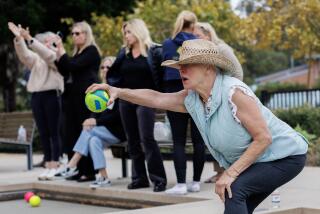Lawn Bowlers on a Roll With New Clubhouse
- Share via
SANTA ANA — As the sun sets on the manicured greens of the Santiago Park Lawn Bowling Center, Tom Stirrat adjusts his white cap, squints and rolls a 4-pound ball down the turf.
Another practice session for the Santa Ana Lawn Bowling Club is just about over and it’s time for Stirrat and the other players to head for the clubhouse.
For decades, the clubhouse has amounted to meeting and storage space in a run-down Army barracks. But today, city officials and lawn bowlers will dedicate an elaborate $900,000 clubhouse that will be the site of the sport’s national championships in October.
“We’ve been waiting for a new building since 1960 and now we finally got it,” said Stirrat, 80, a two-time national lawn bowling champion and the club’s best player.
Although lawn bowling centers also exist in Newport Beach, Laguna Beach, Laguna Niguel and Irvine, the sport has a rich tradition in Santa Ana, where the first lawn bowling green was installed in Santiago Park in 1935 and a second green was added in 1952.
Lawn bowling, which dates back to ancient Egypt, Greece and Rome, involves players trying to roll plastic or wooden balls as close as possible to a smaller target ball, known as a jack. The game can be played individually or in teams.
Up to 16 games can be played on Santiago Park’s 120-foot-long greens, which are surrounded by tall trees and have a serene ambience that is in sharp contrast to the two freeways and shopping mall nearby.
Club members, most of whom are in their 70s or 80s, dress impeccably in the sport’s traditional all-white clothes and move about the lawns with grace and energy. “This is what keeps us young,” said 82-year-old Barbara Nelson. “There are days when you get up in the morning and you’d rather stay home. But then you make yourself go out and do some lawn bowling and you’re always so glad you came.”
Longtime club member Margorie Patterson, 86, publicizes the sport to fellow senior citizens. She claims that lawn bowling, whose origins date to the 13th Century, has kept her active and helped her recover from several surgeries a few years ago.
“This is great exercise for older people,” Patterson said. “You do a lot of bending and walking, you’re out in the fresh air and you can just keep playing for as long as you are able to get around. The sad part is that very few people know about this beautiful game.”
The camaraderie and sportsmanship that exists among local club members and lawn bowlers around the world is one of the main reasons Bill Dietrich took up the sport about a year ago.
“Lawn bowlers are the friendliest group of people around,” said Dietrich. “You could go anywhere in the world to a facility and the members would welcome you with open arms and say, ‘Come bowl.’ It’s sort of a fraternity in that way.”
Although Dietrich, 66, only began serious lawn bowling last year, he said the Santiago Park facility has always had a special place in his heart. When he was 11 years old and growing up in Santa Ana, Dietrich would ride his bicycle to the park and watch as workers built the facility.
Club members hope that the new and improved facility in Santiago Park will help to attract new devotees to the sport.
The grayish-white, 3,400-square-foot clubhouse, with its wooden beams, upper-level viewing area and cement patio, has been the topic of conversation for many months among the lawn bowling club’s 80 members.
The project has been in the planning stages for many years, but was often delayed because of cost, said Ron Ono, park landscape design manager for Santa Ana.
The city was finally able to accumulate enough money to pay for the project by applying for state grants and by using park acquisition and development funds.
“We wanted to create a country club atmosphere with this building and I think we have achieved that,” Ono said.
While the bottom floor of the building will serve as a meeting place and storage facility for club members, the upstairs portion will serve as a community center available for wedding receptions, cultural events and community activities.
“I’d say we finally hit it big,” said Norm Field, president of the club that was founded in 1938. “Before, we were always considered the poor orphans among the other clubs. We feel a lot more confident that people will want to come here now.”
More to Read
Go beyond the scoreboard
Get the latest on L.A.'s teams in the daily Sports Report newsletter.
You may occasionally receive promotional content from the Los Angeles Times.










